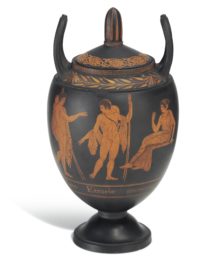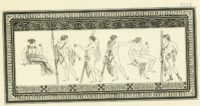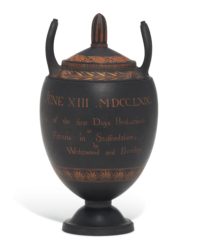 One of four vases made by Josiah Wedgwood on the opening day of his new Etruria Works at Stoke-on-Trent, Staffordshire, has been acquired by the Potteries Museum & Art Gallery after coming within a razor’s width of being exported out of the UK by an overseas buyer. The vase was bought at a Christie’s auction on July 7th, 2016 for £482,500 ($625,759). In December, Culture Minister Matt Hancock placed a temporary export bar on the vase as an object of its rarity and national significance to British art, industrial and ceramic history. It would have been the only one of the four First Day’s Vases to leave the UK. Two are in the Victoria and Albert Museum; the other is still owned by the Wedgwood family.
One of four vases made by Josiah Wedgwood on the opening day of his new Etruria Works at Stoke-on-Trent, Staffordshire, has been acquired by the Potteries Museum & Art Gallery after coming within a razor’s width of being exported out of the UK by an overseas buyer. The vase was bought at a Christie’s auction on July 7th, 2016 for £482,500 ($625,759). In December, Culture Minister Matt Hancock placed a temporary export bar on the vase as an object of its rarity and national significance to British art, industrial and ceramic history. It would have been the only one of the four First Day’s Vases to leave the UK. Two are in the Victoria and Albert Museum; the other is still owned by the Wedgwood family.
After a fundraising campaign that saw donations from hundreds of members of the public, private businesses and institutions like the Art Fund and National Heritage Memorial Fund, Stoke-on-Trent City Council and the Friends of the Potteries Museum & Art Gallery were able to raise the £482,500 purchase price to keep the vase in the UK. They have negotiated with the auction buyer and have worked out the exchange. The vase will now go back to the Potteries Museum & Art Gallery where it was on display, loaned by the owner, the granddaughter of Cecil Wedgwood, from 1981 until it was withdrawn in 2016 to be sold to the highest bidder.
Made of Black Basalt and decorated with a painting technique Wedgwood termed “encaustic” (hand-painted with enamel pigments and a clay slip then fired), six First Day’s Vases, each slightly different, were thrown by Josiah Wedgwood himself on June 13th, 1769, the opening day of his new Etruria factory. His partner Thomas Bentley turned the wheel. Four of the six vases survived the firing process. Wedgwood, who had a real understanding from the very beginning of the importance of preserving his company’s history, specifically noted in a letter to Bentley’s workshop that the vases “sho’d be finish’d as high as you please but not sold, they being the first fruits of Etruria.”
 The figures are copied from a 5th century B.C. Attic red-figure vase in the collection of antiquarian Sir William Hamilton (whose wife, Emma Hamilton, was very notoriously and very scandalously the lover of Admiral Horatio Nelson for seven years before his death at the Battle of Trafalgar in 1805). The vase was published in the illustrated catalogue of Hamilton’s vase collection in 1766 and Josiah Wedgwood got a preview copy of the book because of his connection to Sir William. Hamilton was a generous patron to Wedgwood, giving him access to his collection of vases so he could study and often times duplicate their forms and decoration.
The figures are copied from a 5th century B.C. Attic red-figure vase in the collection of antiquarian Sir William Hamilton (whose wife, Emma Hamilton, was very notoriously and very scandalously the lover of Admiral Horatio Nelson for seven years before his death at the Battle of Trafalgar in 1805). The vase was published in the illustrated catalogue of Hamilton’s vase collection in 1766 and Josiah Wedgwood got a preview copy of the book because of his connection to Sir William. Hamilton was a generous patron to Wedgwood, giving him access to his collection of vases so he could study and often times duplicate their forms and decoration.
The piece that inspired Josiah Wedgwood’s First Vase is an elaborately painted water jar that features dense and complex groupings of figures from Greek mythology — the kidnapping of the Leukippides, Heracles in the garden of the Hesperides — and was considered by art historians of the 18th and 19th centuries as one of the greatest extant examples of Greek design. Today it is known as the Meidias Hydria now that its artist has been identified as the Meidias Painter. It was acquired by the British Museum in 1772 when Hamilton sold his entire vase collection to the institution.
Wedgwood getting access to Hamilton’s collection and an early view of the high quality plates in the catalogue before any other artist gave him a great advantage in the market. Neo-classical decorative arts were all the rage, and Josiah Wedgwood was ideally positioned to fulfill  the public’s craving. Modelled in both shape and decoration directly from the original ancient vessels, the First Day’s Vases tapped into this market with a verisimilitude that none of Wedgwood competitors could boast of, and the influence of Hamilton’s antiquities was felt throughout the Wedgwood line, in vases, tableware, reliefs and patterns.
the public’s craving. Modelled in both shape and decoration directly from the original ancient vessels, the First Day’s Vases tapped into this market with a verisimilitude that none of Wedgwood competitors could boast of, and the influence of Hamilton’s antiquities was felt throughout the Wedgwood line, in vases, tableware, reliefs and patterns.
At the foot of all four of the First Day’s Vases is the inscription “Artes Etrurae Renascuntur,” meaning the Arts of Etruria are Reborn. Josiah Wedgwood played a large role in popularizing neo-classicism, and these vases, the name of his factory, the duplication of elements of ancient vases but on an industrial scale, underscore how central the inspiration of antiquity was to Wedgwood. It was the foundational idea behind the Etruria Works.